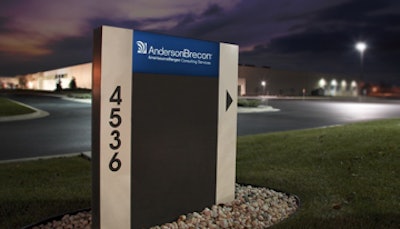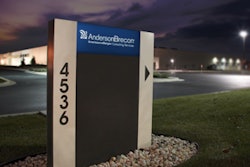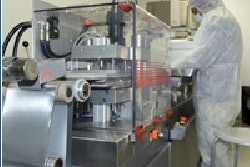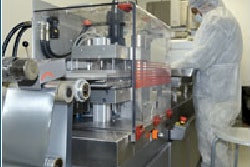Anderson Packaging, a U.S.-based pharmaceutical, clinical, and commercial contract packager, and Brecon Pharmaceuticals, a supplier of pharmaceutical commercial packaging and clinical supply services in the U.K., announced in June they were further aligning their businesses to become a global end-to-end pharmaceutical packaging company under the name AndersonBrecon, as part of AmerisourceBergen Corp.
What does that mean for the company’s pharmaceutical, biologic, and medical device manufacturer customers? Healthcare Packaging discussed that and a range of lifesciences issues with Justin Schroeder, AndersonBrecon’s senior director of marketing and development services.
“We [Anderson Packaging] have been working collaboratively with our sister company Brecon Pharmaceuticals for probably about six years now,” says Schroeder. “They serve primarily the European market and they have complementary services to what we have here in the U.S. These include the packaging of investigational medicines, as well as the storage and distribution of those products worldwide. This includes global commercial packaging as well. We have these services both in the U.S. and in the U.K. to handle products from early phase-one clinical trial development all the way through to the commercial launch and beyond.”
In the past, Anderson Packaging and Brecon Pharmaceuticals each provided services for its customers. Under AndersonBrecon, there can be more flexibility in determining where a customer’s product will be packaged.
Schroeder explains, “Based on the needs of the geography of the region, Europe has some unique requirements. There are so many countries in that global region, typically with volumes more modest than in the U.S. The U.K. services are formatted to meet that market’s needs for quick changeover and one product with many SKUs, whether it be in France, in Turkey, in Italy or in other countries. So they have a lot of insight into those market areas and each country’s unique requirements.
“We package many products in the U.S. that are distributed and sold globally. But we do have customers looking at doing packaging at both locations to best serve their global markets. So it may be that we package for North America here in Rockford [IL], and we package for the E.U. countries in Europe. We are positioned to support that growth as the market continues to develop and customers gain regulatory approval [to market products] in many different countries.” The BRIC countries—Brazil, Russia, India, and China—show considerable promise, Schroeder adds.
AndersonBrecon has a global network of storage and distribution facilities, providing packaged medications to patients in more than 100 countries. As part of the repositioning, AndersonBrecon will become a component of AmerisourceBergen Consulting Services (ABCS), a business unit of AmerisourceBergen that comprises consulting companies that include Xcenda, Lash Group, TheraCom, and Premier Source.
Says ABCS president Peyton Howell, “Moving to a more global organization will better position us to offer our customers a more integrated approach for the global launch of pharmaceutical products, helping to accelerate speed-to-market and product success.”
Here are some of the key issues Schroeder says are having an impact on AndersonBrecon and its customers:
Combination products. The company’s forte may be in pharmaceutical and biologic/biopharmaceutical packaging, but Schroeder points to the medical device sector as a growing area, particularly where medical device and biologic therapies come together. “We’re definitely seeing requests for development of delivery forms to meet the needs for those types of products,” he says.
One particular combination product in which Schroeder sees strong demand is injectable pens, whose protected housing “eases delivery and injection for the person who is administering the product, be that in a clinical setting or self-administration.”
In this instance, the pen is the medical device and the product is a biologic or biopharmaceutical. Although not always the case with pens, many combination product can create additional challenges in that they may be sensitive to any number of factors, primarily temperature.
Schoeder explains, “These products are often complex assemblies that typically need considerable diligence and precision in [assembly and filling]. They may require special handling and must be transported in a cold chain environment, with very limited excursion time. They may even have to be packaged in a cold environment.” He sees auto injectors, syringes, vials, and other special devices, both branded and generic, as growth products within the combination product category.
Biosimilars. Schroeder explains, “As some of the more mature branded biologic products come off patent protection, generic companies are eyeing that market as an effective growth area. Also, branded pharmaceutical companies may look into producing a generic equivalent of what was a branded competitor.
“The maker of the biosimilar has to demonstrate that the product is as efficacious and similar to the branded product that’s been on the market. With biologics, that’s a much more challenging proposition,” compared to pharmaceuticals. “There could be several products and several generic equivalents for what had been a branded product that went off patent. It’s a whole new area for the market as some of the first biologic products available on the market are now losing their patent exclusivity.”
Lower-volume, higher-value products. “We see the market shifting,” Schroeder relates. “The days of the blockbuster drugs seem to be over. Many of the products that we are supporting now are much more modest in terms of overall volume but at the same time they are extremely high-value products and specialized medicines. So many of the investments that we’ve been making in our business, both in the E.U. as well as in the U.S., have been to support that type of product.”
Patient adherence. AndersonBrecon has been involved in developing compliance-prompting packaging for years. Asked how he sees such packaging faring in the future, Schroeder says, “I anticipate continued growth. As physician sampling is reduced, pharmaceutical companies are looking to strengthen their investment in what they provide to customers. So we are seeing targeted starter packs, a more targeted package addressing the many issues of compliance and adherence such as calendarization, cost, managing side effects, lifestyle changes. etcetera. We are noticing more attention being paid to compliance-prompting packaging in products sold at the pharmacy. I think the MeadWestvaco-Walmart study that was produced opened a lot of eyes in that even packs with simple calenderization of medicine can have a substantial impact on adherence.”
Such packaging has been accepted in Europe for years, but progress has been somewhat slow in the U.S. “Europe does have its own compliance and adherence challenges,” says Schroeder. “Simply putting product in a blister is not a silver bullet in terms of solving some of those challenges because compliance is a multifaceted issue. We have a lot to learn from how they do things in Europe in terms of unit-dose packaging and protection, but their consumers are more used to wallets or blister packs and they have accepted them for decades.” As a side note, he says that while U.S. prescriptions are often in 30-, 60-, or 90-day quantities, doses in the E.U. tend to be 7, 14, or 28 days.
Serialization. Schroeder says, “AndersonBrecon takes a flexible approach to our infrastructure because there is no standard yet and different customers are going to want different options. We have situations where some customers will be providing us serialized numbers and they want us to apply those and account for every single one of them. There are other situations where customers ask us to generate those numbers and make sure that we are maintaining that data integrity.” He says serialization can include primary, secondary, and tertiary packaging, aggregating those relationships, and handling data storage and transfer. “It’s a challenging activity for sure.
“We have benefitted from our relationship with AmerisourceBergen and having been actively serializing product for commercial programs over the past 24 months. This has allowed us to work through many of these challenges and has us well positioned for wherever the standards are finally settled.”
In the medical device area, unique identification numbers are a developing issue for manufacturers. “Certainly the device market has the same challenges as the pharmaceutical market in terms of the financial attractiveness of counterfeit products and the need for integrity of the supply chain,” he adds.
Sustainability. Schroder notes that sustainability is also factoring into the business, not just in terms of customers suggesting packaging materials, but in plant efficiencies. “From time to time we see customers requesting certain materials, but we are making investments at our own faculties. We are taking a lot of those considerations into play in terms of energy management and having a green footprint.”
Global growth fuels the future
Looking forward, Schroeder says, “We are truly a global-based company, positioned with services both in the U.S. and in Europe to meet the needs of a global market. The benefit of having packaging in the E.U. as well as distribution is that we can be much more strategic about where we package for the local to the regional market and make that a very efficient process. The global market is changing the needs of our pharmaceutical customers and we are looking to provide them services that reflect their business needs.”
So rather than contract packaging at Anderson Packaging’s Rockford site, then sending product to a customer in Ireland, it now might be more efficient to do at AndersonBrecon in Europe—or vice versa. He says, “If there is a market that our U.K. team has been serving, and one of their customers has been looking to get access to North America, then we might package their products here.
“We have gone through this rebranding effort and tying together our companies, and we’ve made substantial investments to continue to grow and expand our facilities both in the U.S. and in the E.U., adding capabilities to meet current and future market needs. As we see trends for global growth, for example, products for the cold chain, controlled substances, and other developing areas, we will invest to support packaging of those types of products.”


























